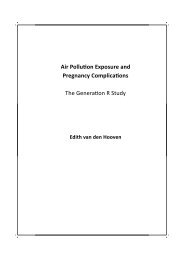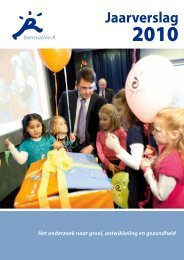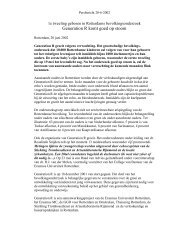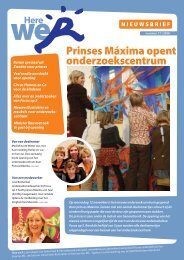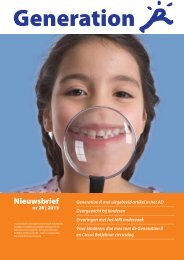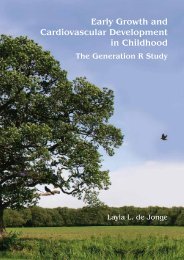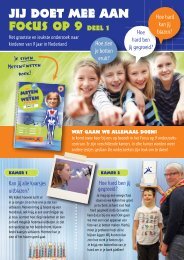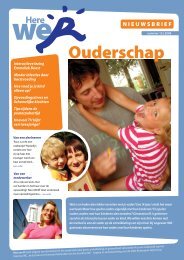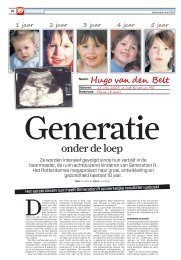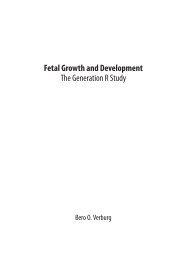Parents and infants: determinants of attachment in a ... - Generation R
Parents and infants: determinants of attachment in a ... - Generation R
Parents and infants: determinants of attachment in a ... - Generation R
Create successful ePaper yourself
Turn your PDF publications into a flip-book with our unique Google optimized e-Paper software.
Attachment, depression, <strong>and</strong> cortisol: Deviant patterns <strong>in</strong> <strong>in</strong>secure-resistant <strong>and</strong> disorganized <strong><strong>in</strong>fants</strong><br />
Third, a relatively large part <strong>of</strong> the participants could not be <strong>in</strong>cluded <strong>in</strong><br />
cortisol analyses, due to various reasons. Clearly <strong>in</strong>form<strong>in</strong>g parents about<br />
sampl<strong>in</strong>g could help to ga<strong>in</strong> more <strong>and</strong> better saliva samples, however,<br />
sampl<strong>in</strong>g might rema<strong>in</strong> difficult <strong>in</strong> 14-month-olds. Lastly, a slightly shortened<br />
version <strong>of</strong> the SSP was used, <strong>in</strong> order to make it fit <strong>in</strong>to the schedule<br />
<strong>of</strong> the visit. This m<strong>in</strong>imal procedural change did not appear to modify the<br />
stress <strong>of</strong> the SSP, s<strong>in</strong>ce the number <strong>of</strong> <strong><strong>in</strong>fants</strong> for whom the situation appears<br />
to be most stressful (resistant <strong>and</strong> disorganized classifications) was not lower<br />
<strong>in</strong> the current study compared to the st<strong>and</strong>ard distribution.<br />
Conclusion<br />
We documented the vulnerability <strong>of</strong> resistant <strong><strong>in</strong>fants</strong> <strong>in</strong> physiological<br />
stress regulation, especially <strong>in</strong> comb<strong>in</strong>ation with care from a mother with<br />
a lifetime diagnosis <strong>of</strong> depression. Because <strong>of</strong> their small numbers <strong>in</strong> most<br />
<strong>attachment</strong> studies, resistant <strong><strong>in</strong>fants</strong> have been understudied as a separate<br />
<strong>in</strong>secure group. Our f<strong>in</strong>d<strong>in</strong>g <strong>of</strong> elevated physiological stress reactivity<br />
<strong>in</strong> resistant children makes clear that this group can <strong>and</strong> should be differentiated<br />
from the other <strong>in</strong>secure <strong>attachment</strong> groups. We also showed that<br />
disorganized <strong><strong>in</strong>fants</strong> differed from non-disorganized <strong><strong>in</strong>fants</strong> <strong>in</strong> their diurnal<br />
cortisol rhythm, as they displayed a more flattened daily curve. This f<strong>in</strong>d<strong>in</strong>g<br />
stresses the disturbed nature <strong>of</strong> disorganized <strong>attachment</strong>s as one <strong>of</strong> the most<br />
important risks for developmental psychopathology. Our large-sample study<br />
suggests the differential physiological concomitants <strong>of</strong> avoidant, resistant,<br />
<strong>and</strong> disorganized <strong>attachment</strong>s. Because <strong>in</strong>fant <strong>attachment</strong> patterns have<br />
been shown to be relatively stable <strong>in</strong> stable environments (Fraley, 2002) <strong>in</strong>secure<br />
<strong>attachment</strong>s may have long-term consequences for mental health, <strong>in</strong><br />
particular <strong>in</strong> comb<strong>in</strong>ation with other risk factors such as parental depression.<br />
Here we found that <strong>in</strong>secure-resistant <strong>and</strong> disorganized <strong>attachment</strong>s<br />
can go ‘under the sk<strong>in</strong>’ <strong>and</strong> may lead to deviat<strong>in</strong>g cortisol reactivity <strong>and</strong><br />
daily patterns. From a biological perspective (Sapolsky, 2004) adverse early<br />
experiences can make humans <strong>and</strong> other animals more prone to stress <strong>and</strong><br />
stress-related diseases, <strong>and</strong> <strong>attachment</strong> relationships may mediate the <strong>in</strong>tergenerational<br />
transmission (Meaney, 2001) <strong>of</strong> this elevated vulnerability to<br />
emotional dysregulation.<br />
<br />
101



